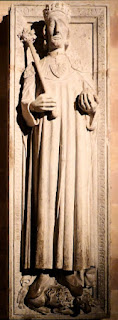Last Saturday, Red Baron visited the exhibition Die Habsburger, Aufstieg einer Dynastie im Mittelalter at the Historical Museum of the Palatinate in Speyer. Already on the way in the bus, an expert informed us about the history of the early Habsburgs. Later, there was a guided tour through the exhibition, during which, unfortunately, taking pictures was not allowed.
The Habsburgs run like a thread through my website Freiburgs Geschichte in
Zitaten. At the latest, since 1368, the Habsburgs were present in Freiburg as
rulers and remained so for 438 years until the handover of the Breisgau to the
Grand Duchy of Baden decreed by Napoleon in 1806. The German-reading visitors
of my blogs may
start reading here with the election of Rudolf of Habsburg as German king.
So I will not give an outline of Habsburg history in the following, especially since there is a humorous account by Simon Winder. I limit myself to some highlights that I have not yet heard.
So I will not give an outline of Habsburg history in the following, especially since there is a humorous account by Simon Winder. I limit myself to some highlights that I have not yet heard.
Rudolf's Epitaph
Rudolfs wanted to be buried in the crypt of Speyer Cathedral, built by the Salians and intended as a burial place, among the very great of the empire. After riding to Speyer, about twenty kilometers from Germersheim, he died on July 15, 1291, in the shadow of the cathedral. Only three days later, Rudolf was buried in the imperial crypt in the empty grave of Frederick I, Barbarossa*.
*The Staufer emperor drowned in the Saleph River in Asia in 1190, so the Speyer tomb remained empty until Rudolf's death.
A funerary monument with a lifelike representation of the buried was first placed in the cathedral, then moved to the place of Rudolf's death, the Johanniterhof in Speyer, in the 16th century. The epitaph was later stored in a cowshed, among other places, and became lost. After its rediscovery in 1811, it was restored and subsequently moved back into the Speyer Cathedral.
|
|
Hands, arms, and the scepter on the left were reconstructed, while
on the right, an imperial orb was added instead of the lidded
vessel.
The Late Maximilian
He was also preoccupied with the representation of his intact family life.

|
| ©Österreichische Nationalbibliothek |
Emperor Maximilian stands on the left side of the picture, holding his
grandson Ferdinand in his arms. The ruler's left arm rests on
Charles' shoulder. Maximilian's son Philip the Fair, stands behind his mother,
Mary of Burgundy. Maximilian's granddaughter
Mary
is before her husband, grandson-in-law
Louis of Hungary. Maximilian, Philipp, and Charles, decorated with the chain of the
Order of the Golden Fleece, wear a beret, and Ferdinand and Ludwig have
a wreath in their hair.

|
| ©Haselburg-müller/Wikipedia |
We read in Wikipedia: Like other kings and emperors of the Middle Ages, Maximilian staged his death. Having already carried his coffin with him at all times for four years, in the face of death, he presented himself as an exceptionally humble and guilt-ridden sinner and penitent. He decreed that his body be scourged and that his hair be shorn, and teeth were broken out.
True to his will, Maximilian I was buried in his baptismal church at the castle in Wiener Neustadt. His heart was interred separately in the Church of Our Lady in Bruges in the sarcophagus of Mary of Burgundy.
Maximilian's famous tomb with numerous bronze figures, which he had commissioned during his lifetime, remained unfinished. His grandson Ferdinand assembled the fragments in a specially built court church in Innsbruck.
The guided tour of the exhibition lasted more than two hours. I had lunch at a nearby
restaurant, eating a Palatinate plate:

|
|
Saumagen, Leberknödel (liver dumpling), bratwurst, wine
sauerkraut, fried potatoes and fresh farmhouse bread |
*





No comments:
Post a Comment